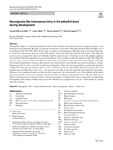Mostrar o rexistro simple do ítem
Neurogranin-Like Immunoreactivity in the Zebrafish Brain During Development
| dc.contributor.author | Alba-González, Anabel | |
| dc.contributor.author | Yáñez, Julián | |
| dc.contributor.author | Anadón, Ramón | |
| dc.contributor.author | Folgueira, Mónica | |
| dc.date.accessioned | 2024-03-01T17:09:48Z | |
| dc.date.available | 2024-03-01T17:09:48Z | |
| dc.date.issued | 2022-08-26 | |
| dc.identifier.citation | Alba-González, A., Yáñez, J., Anadón, R. et al. Neurogranin-like immunoreactivity in the zebrafish brain during development. Brain Struct Funct 227, 2593–2607 (2022). https://doi.org/10.1007/s00429-022-02550-6 | es_ES |
| dc.identifier.issn | 1863-2661 | |
| dc.identifier.uri | http://hdl.handle.net/2183/35765 | |
| dc.description.abstract | [Abstract] Neurogranin (Nrgn) is a neural protein that is enriched in the cerebral cortex and is involved in synaptic plasticity via its interaction with calmodulin. Recently we reported its expression in the brain of the adult zebrafish (Alba-González et al. J Comp Neurol 530:1569–1587, 2022). In this study we analyze the development of Nrgn-like immunoreactivity (Nrgn-like-ir) in the brain and sensory structures of zebrafish embryos and larvae, using whole mounts and sections. First Nrgn-like positive neurons appeared by 2 day post-fertilization (dpf) in restricted areas of the brain, mostly in the pallium, epiphysis and hindbrain. Nrgn-like populations increased noticeably by 3 dpf, reaching an adult-like pattern in 6 dpf. Most Nrgn-like positive neurons were observed in the olfactory organ, retina (most ganglion cells, some amacrine and bipolar cells), pallium, lateral hypothalamus, thalamus, optic tectum, torus semicircularis, octavolateralis area, and viscerosensory column. Immunoreactivity was also observed in axonal tracts originating in Nrgn-like neuronal populations, namely, the projection of Nrgn-like immunopositive primary olfactory fibers to olfactory glomeruli, that of Nrgn-like positive pallial cells to the hypothalamus, the Nrgn-like-ir optic nerve to the pretectum and optic tectum, the Nrgn-like immunolabeled lateral hypothalamus to the contralateral region via the horizontal commissure, the octavolateralis area to the midbrain via the lateral lemniscus, and the viscerosensory column to the dorsal isthmus via the secondary gustatory tract. The late expression of Nrgn in zebrafish neurons is probably related to functional maturation of higher brain centers, as reported in the mammalian telencephalon. The analysis of Nrgn expression in the zebrafish brain suggests that it may be a useful marker for specific neuronal circuitries. | es_ES |
| dc.description.sponsorship | Open Access funding provided thanks to the CRUE-CSIC agreement with Springer Nature. Alba-González A. is recipient of a Predoctoral Fellowship from Xunta de Galicia (Grant number ED481A-2019/003) | es_ES |
| dc.description.sponsorship | Xunta de Galicia; ED481A-2019/003 | es_ES |
| dc.language.iso | eng | es_ES |
| dc.publisher | Springer Nature | es_ES |
| dc.relation.uri | https://doi.org/10.1007/s00429-022-02550-6 | es_ES |
| dc.rights | Atribución 4.0 Internacional | es_ES |
| dc.rights.uri | http://creativecommons.org/licenses/by/4.0/ | * |
| dc.subject | Neurogranin | es_ES |
| dc.subject | RC3 | es_ES |
| dc.subject | Immunohistochemistry | es_ES |
| dc.subject | Brain development | es_ES |
| dc.subject | Teleost | es_ES |
| dc.subject | Danio rerio | es_ES |
| dc.title | Neurogranin-Like Immunoreactivity in the Zebrafish Brain During Development | es_ES |
| dc.type | info:eu-repo/semantics/article | es_ES |
| dc.rights.access | info:eu-repo/semantics/openAccess | es_ES |
| UDC.journalTitle | Brain Structure and Function | es_ES |
| UDC.volume | 227 (2022) | es_ES |
| UDC.startPage | 2593 | es_ES |
| UDC.endPage | 2607 | es_ES |
| dc.identifier.doi | 10.1007/s00429-022-02550-6 |






